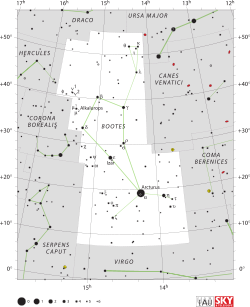Upsilon Boötis
Appearance
| Observation data Epoch J2000 Equinox J2000 | |
|---|---|
| Constellation | Boötes |
| Right ascension | 13h 49m 28.64s[1] |
| Declination | +15° 47′ 52.5″[1] |
| Apparent magnitude (V) | 4.053 |
| Characteristics | |
| Spectral type | K5.5III |
| U−B color index | 1.87 |
| B−V color index | 1.52 |
| R−I color index | 0.87 |
| Variable type | Variable star |
| Astrometry | |
| Radial velocity (Rv) | -5.6 km/s |
| Proper motion (μ) | RA: -94.22 ± 0.19[1] mas/yr Dec.: 41.07 ± 0.14[1] mas/yr |
| Parallax (π) | 12.38 ± 0.23 mas[1] |
| Distance | 263 ± 5 ly (81 ± 2 pc) |
| Details | |
| Mass | 1.11 ± 0.33[2] M☉ |
| Luminosity | 332 ± 54[2] L☉ |
| Temperature | 3,920[2] K |
| Other designations | |
| Database references | |
| SIMBAD | data |
| Data sources: | |
| Hipparcos Catalogue, CCDM (2002), Bright Star Catalogue (5th rev. ed.) | |
Upsilon Boötis (υ Boo, υ Boötis) is a star in the constellation Boötes.
Upsilon Boötis is an orange K-type giant with an apparent magnitude of +4.05. It is approximately 263 light years from Earth.[1]
References
- ^ a b c d e f van Leeuwen, F. (November 2007), "Validation of the new Hipparcos reduction", Astronomy and Astrophysics, 474 (2): 653–664, arXiv:0708.1752, Bibcode:2007A&A...474..653V, doi:10.1051/0004-6361:20078357.
- ^ a b c Stello, D.; et al. (2008), "Oscillating K Giants with the WIRE Satellite: Determination of Their Asteroseismic Masses", The Astrophysical Journal Letters, 674 (1): L53–L56, arXiv:0801.2155, Bibcode:2008ApJ...674L..53S, doi:10.1086/528936.

